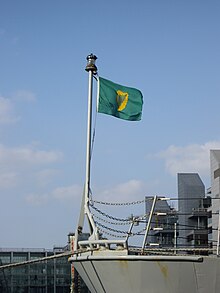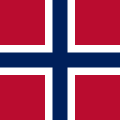Gösch (seafaring)
As Gösch is Bugflagge designated ships.
origin
The name is traced back to the Geusen - the Dutch freedom fighters of the 16th century - although the flag was not used at this point during the Geusen times. It was not until after 1600 that flags on the bowsprit or on the spriet mast can be documented with sources. At this point, however, the geusen are no longer available.
use

In the merchant shipping, it used to be common to put a jack in the harbor and to sail on ships in liner service. According to the German ordinance on flag flying of 1933, German ships had to use the swastika flag instead of the flag of their home port.
Nowadays the jack is especially used on warships . It is only set when the ship is in port . This is also the case with the German Navy , where when the ship docks, the jack is placed on the bow and the federal service flag of the naval forces is placed on the stern. When the ship casts off, the two flags are raised and the federal service flag is set on the mast. Some other naval forces show the jack at sea on the bow and the naval war flag in the port at the stern.
In civil shipping today, the jack is mostly used on passenger ships and traditionally on special occasions such as the Hamburg port birthday .
The ships of the German Society for the Rescue of Shipwrecked People ( DGzRS ) carry the “ Bremer Speckflagge ” permanently as Gösch .
Appearance
In many countries the jack is identical to the merchant flag or naval war flag, as is the case with the German Navy. Other states use variations in size or aspect ratio ( Norway , for example, has a square variation) or use flags with their own design, such as Spain or the United States . The flag of the home port is also set less often than Gösch.
See also
Web links
Individual evidence
- ↑ Arnold Kludas : The History of German Passenger Shipping , Vol. 5: An era goes to the end of 1930 to 1990 . (= Writings of the German Maritime Museum, Vol. 22). 1990, ISBN 3-8225-0041-0 , p. 15.





